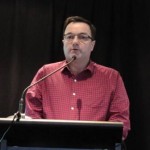Silver Fern Farms has reported a net operating loss after tax for the 12 months ended 30 September 2012 of $31.1 million (2011 profit $30.8 million) from total revenue of $2 billion.
 Silver Fern Farms chairman Eoin Garden says that, despite an operational loss, the company’s balance sheet was robust (44 percent equity ratio); and significant investments had been made in 2012 to underpin future growth, including new marketing initiatives ($8 million) and the new Te Aroha plant ($67 million).
Silver Fern Farms chairman Eoin Garden says that, despite an operational loss, the company’s balance sheet was robust (44 percent equity ratio); and significant investments had been made in 2012 to underpin future growth, including new marketing initiatives ($8 million) and the new Te Aroha plant ($67 million).
In addition, Silver Fern Farms had also made a significant investment of $4 million in FarmIQ in 2012. Now in year three of the seven-year build timeframe, not only will FarmIQ become the enabler for farmers to deliver the required product to meet Silver Fern Farms’ marketing and sales plans, but it will also empower farmers to identify opportunities on farm to grow their productive capacity, thereby generating more value from within their own farming businesses.
Garden says it is important to highlight the commitment the company had made to forge ahead with the implementation of the business’ overall growth strategy for the future of Silver Fern Farms, its shareholders, suppliers and people, notwithstanding this poor 12-month financial performance.
“In the 2012/13 financial year, Silver Fern Farms plans to invest a further $22.6 million into brand development and marketing initiatives to build brand equity, channel and market development, and FarmIQ. That clearly demonstrates our confidence in, and commitment to, the growth path we have charted for our co-operative” says Garden.
 Chief executive Keith Cooper comments that Silver Fern Farms operates in an environment where many outcomes are beyond the company’s control but materially impact on the business.
Chief executive Keith Cooper comments that Silver Fern Farms operates in an environment where many outcomes are beyond the company’s control but materially impact on the business.
“Climatically, we went into the 2011/12 season with ideal pasture growing conditions which meant livestock was held on farm for valid reasons. This resulted in markets being short of product versus historical supply patterns. Off the back of this, we saw global prices for lamb in particular, escalate to unsustainable levels, which resulted in a sharp fall in demand and which then led to a significant decline in value. This market correction was subsequently reflected back to suppliers and, in turn, caused write-downs in inventory valuations throughout the financial year of circa $25.6 million. Through this period, Silver Fern Farms had to manage business continuity – supplying to customers and operating processing assets – which meant we had to compete for livestock at unsustainable prices which further contributed to the problem.”
Cooper reiterated that while this was a poor year financially, strategically it was a progressive one.
“2012 marked a continuation of our unwavering commitment to executing our Plate-to-Pasture strategy. This is a progressive and long-term plan, which demands perseverance and determination, to ultimately generate sustainable value for our farmer-partners, by meeting the modern consumer’s requirements.”
Over the last four years, Silver Fern Farms has invested in designing the brand detail and marketing infrastructure required to drive a greater proportion of its revenue through premium value branded products. “Our differentiated approach means that our brand has now become integrated across all areas of the business – corporate, supplier service, operations, sales and consumer activities – and we are now starting to see the benefits of this throughout the value chain” says Cooper.
While Silver Fern Farms’ final inventory position for 2012 was up versus the previous year, he advises that this had decreased markedly since balance date, with the increased working capital being driven by those higher balance date inventories.
Eoin Garden also advised that incumbent director Angus Mabin, who retired by rotation, has been re-appointed unopposed, which gives the board confidence they have continuing shareholder support.
Silver Fern Farms is New Zealand’s leading processor and marketer of lamb, mutton, beef, venison and associated products to more than 60 countries.
The summary of key financial items for the year ending 30 September 2012, includes:
- Turnover of $2.03 billion (as opposed to $2.1 billion for the year ending 30 September 2011)
- Net result after tax of $31.1 million (2011 $30.8 million)
- Operating cash flow (deficit) in 2012 of ($105.6m) (2011 [$7.5m])
- Equity ratio at balance date 44% (2011 59%)
